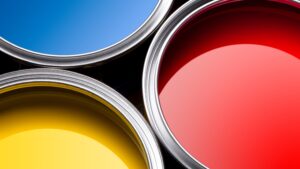Mixing leftover latex paint is not only a fun way to experiment with colours, but it’s also an environmentally friendly practice that promotes sustainability. Instead of discarding unused paint at a recycling location, why not use the leftover to mix different colours to create custom shades for your next project? The creative possibilities are endless!
To begin, gather all the leftover latex paint you’ve stored from previous projects. It’s important to label each container so you can easily identify the original colours. Latex paint is typically water-based, so be sure not to mix it with oil-based or other types of paint, as they won’t blend properly and reduce its recyclability.
Why mix paint?
Mixing colours isn’t just a great way to breathe new life into your projects; it’s also a fun, budget-friendly, and eco-conscious choice. Imagine creating your own custom shades to transform your space—whether it’s an accent wall or a piece of furniture you’ve been wanting to refresh. How exciting to think that these unique colours are born from leftover paints you already have!
Not only does this practice cut down on waste, keeping those half-empty paint cans out of landfills, but it also plays a role in supporting Canada’s circular economy. In a circular economy, we keep resources in use longer, reducing the need for new raw materials.
However, when mixing paint, it’s important to remember that this can impact its recyclability. If you mix colours that are in less demand, it could make the paint less desirable for reuse. That’s why it’s best to mix paint with the goal of using it up rather than expecting it to be recycled afterward.
With the growing environmental challenges we face today—like the longer and hotter summers in some parts of Canada—every little effort counts. By mixing and reusing your leftover paint, you’re contributing to a more sustainable future while reducing your carbon footprint. Plus, it’s a fun way to unleash your creativity and make something truly unique.
Paint colour mixing ideas
If you’re not sure where and what colours to start with, here are a few tips on mixing colours:
- Primary colours
- Soft pink pastel
- Earthy tones
- Layers
- Mix primary colours: Combine primary colours (red, blue, yellow) to create secondary colours like purple, green, and orange.
- Soften bright colours: Want a softer, pastel look? Try mixing bright colours with white to lighten the shade. For example, mixing red and white creates a soft pink.
- Create earthy tones: Combine darker hues like blue and brown to achieve more neutral, earthy tones—perfect for a calming interior.
- Layering the colours: Don’t hesitate to layer colours and blend them gradually. Mixing small amounts at a time and building up the colour allows for greater control over the final shade.
You can also experiment with light and dark colours. For example, if you have blue and yellow leftover paint, you can mix it up and create different shades of green. To achieve this:
- Blue + Yellow: Start by mixing blue and yellow to create your base green.
- Blue + Yellow + White: Add white to lighten the shade for a more pastel green.
- Blue + Yellow + Black: For darker greens, like olive or forest, mix in a small amount of black.
Note: One important thing to keep in mind when mixing your own colours is that it can be challenging to replicate the exact shade in the future. Unlike store-bought paints, these custom blends are unique, and recreating the exact hue might be difficult if you ever need to touch up or repaint an area. To mitigate this, consider keeping a record of the paint proportions used, although perfect replication is still not guaranteed. If this situation arises, it also presents an opportunity to create (again) a new, fresh colour for your space!
Looking for more ways to use leftover paint?
Try painting plant pots for a quick and easy project that adds personality to your garden or home decor. You can follow our step-by-step guide on How to paint plant pots to brighten up your space.
And if you’re deciding on the right colours to mix, you can explore our blog on 4 tips for choosing paint colours in your home. It’s packed with insights to help you select the perfect shades for your interior.
Don’t be afraid to keep experimenting—the beauty of mixing colours is the endless possibilities! Just remember to take notes on your colour formulas so you can recreate them. For more project ideas, check out 4 breathtaking accent wall ideas that are simpler than you think.
If you’re looking to dive into more advanced techniques or explore colour theory further, it’s always helpful to consult with a paint expert in your local area or look up guides online for inspiration.
Repurpose paint with PaintShare
Beyond mixing, another great way to reuse latex paint is through Product Care’s PaintShare program. Instead of letting perfectly good paint go to waste, PaintShare allows consumers to pick up leftover paint for free. It’s a fantastic way to give old paint a second life while benefiting others and the environment.
Note that not all recycling locations participate in the PaintShare program, so if you’re simply looking to drop off leftover paint for recycling, check out the nearest paint recycling locations.







